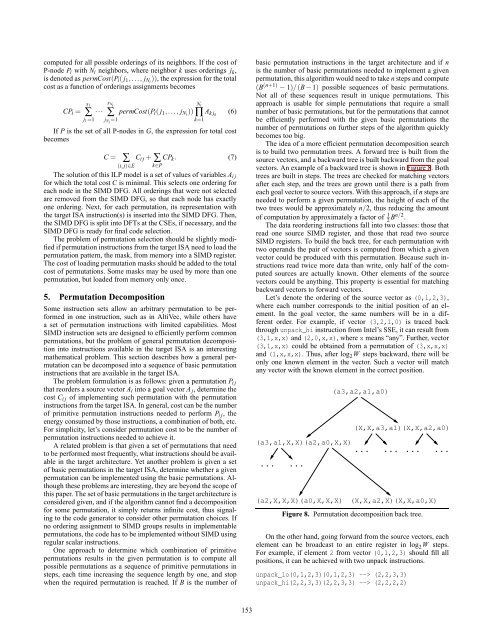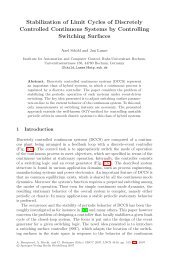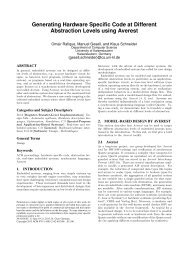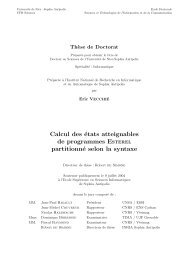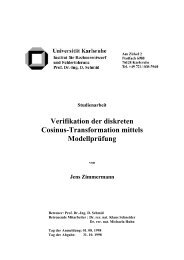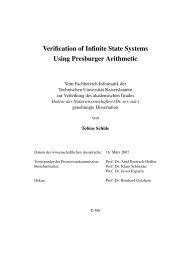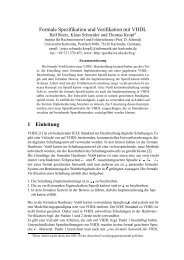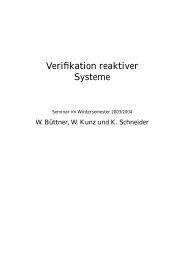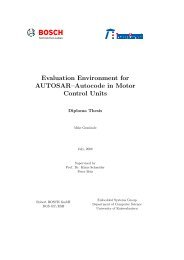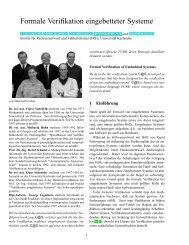Generation of permutations for {SIMD} processors - Embedded ...
Generation of permutations for {SIMD} processors - Embedded ...
Generation of permutations for {SIMD} processors - Embedded ...
Create successful ePaper yourself
Turn your PDF publications into a flip-book with our unique Google optimized e-Paper software.
computed <strong>for</strong> all possible orderings <strong>of</strong> its neighbors. If the cost <strong>of</strong><br />
P-node P i with N i neighbors, where neighbor k uses orderings j k ,<br />
is denoted as permCost(P i ( j 1 ,..., j Ni )), the expression <strong>for</strong> the total<br />
cost as a function <strong>of</strong> orderings assignments becomes<br />
CP i =<br />
s 1<br />
∑ ···<br />
j 1 =1<br />
s Ni<br />
∑<br />
j Ni =1<br />
permCost(P i ( j 1 ,..., j Ni )) A k jk (6)<br />
k=1<br />
If P is the set <strong>of</strong> all P-nodes in G, the expression <strong>for</strong> total cost<br />
becomes<br />
N i<br />
∏<br />
C = ∑ C i j + ∑ CP k . (7)<br />
(i, j)∈E k∈P<br />
The solution <strong>of</strong> this ILP model is a set <strong>of</strong> values <strong>of</strong> variables A i j<br />
<strong>for</strong> which the total cost C is minimal. This selects one ordering <strong>for</strong><br />
each node in the <strong>SIMD</strong> DFG. All orderings that were not selected<br />
are removed from the <strong>SIMD</strong> DFG, so that each node has exactly<br />
one ordering. Next, <strong>for</strong> each permutation, its representation with<br />
the target ISA instruction(s) is inserted into the <strong>SIMD</strong> DFG. Then,<br />
the <strong>SIMD</strong> DFG is split into DFTs at the CSEs, if necessary, and the<br />
<strong>SIMD</strong> DFG is ready <strong>for</strong> final code selection.<br />
The problem <strong>of</strong> permutation selection should be slightly modified<br />
if permutation instructions from the target ISA need to load the<br />
permutation pattern, the mask, from memory into a <strong>SIMD</strong> register.<br />
The cost <strong>of</strong> loading permutation masks should be added to the total<br />
cost <strong>of</strong> <strong>permutations</strong>. Some masks may be used by more than one<br />
permutation, but loaded from memory only once.<br />
5. Permutation Decomposition<br />
Some instruction sets allow an arbitrary permutation to be per<strong>for</strong>med<br />
in one instruction, such as in AltiVec, while others have<br />
a set <strong>of</strong> permutation instructions with limited capabilities. Most<br />
<strong>SIMD</strong> instruction sets are designed to efficiently per<strong>for</strong>m common<br />
<strong>permutations</strong>, but the problem <strong>of</strong> general permutation decomposition<br />
into instructions available in the target ISA is an interesting<br />
mathematical problem. This section describes how a general permutation<br />
can be decomposed into a sequence <strong>of</strong> basic permutation<br />
instructions that are available in the target ISA.<br />
The problem <strong>for</strong>mulation is as follows: given a permutation P i j<br />
that reorders a source vector A i into a goal vector A j , determine the<br />
cost C i j <strong>of</strong> implementing such permutation with the permutation<br />
instructions from the target ISA. In general, cost can be the number<br />
<strong>of</strong> primitive permutation instructions needed to per<strong>for</strong>m P i j , the<br />
energy consumed by those instructions, a combination <strong>of</strong> both, etc.<br />
For simplicity, let’s consider permutation cost to be the number <strong>of</strong><br />
permutation instructions needed to achieve it.<br />
A related problem is that given a set <strong>of</strong> <strong>permutations</strong> that need<br />
to be per<strong>for</strong>med most frequently, what instructions should be available<br />
in the target architecture. Yet another problem is given a set<br />
<strong>of</strong> basic <strong>permutations</strong> in the target ISA, determine whether a given<br />
permutation can be implemented using the basic <strong>permutations</strong>. Although<br />
these problems are interesting, they are beyond the scope <strong>of</strong><br />
this paper. The set <strong>of</strong> basic <strong>permutations</strong> in the target architecture is<br />
considered given, and if the algorithm cannot find a decomposition<br />
<strong>for</strong> some permutation, it simply returns infinite cost, thus signaling<br />
to the code generator to consider other permutation choices. If<br />
no ordering assignment to <strong>SIMD</strong> groups results in implementable<br />
<strong>permutations</strong>, the code has to be implemented without <strong>SIMD</strong> using<br />
regular scalar instructions.<br />
One approach to determine which combination <strong>of</strong> primitive<br />
<strong>permutations</strong> results in the given permutation is to compute all<br />
possible <strong>permutations</strong> as a sequence <strong>of</strong> primitive <strong>permutations</strong> in<br />
steps, each time increasing the sequence length by one, and stop<br />
when the required permutation is reached. If B is the number <strong>of</strong><br />
basic permutation instructions in the target architecture and if n<br />
is the number <strong>of</strong> basic <strong>permutations</strong> needed to implement a given<br />
permutation, this algorithm would need to take n steps and compute<br />
(B (n+1) − 1)/(B − 1) possible sequences <strong>of</strong> basic <strong>permutations</strong>.<br />
Not all <strong>of</strong> these sequences result in unique <strong>permutations</strong>. This<br />
approach is usable <strong>for</strong> simple <strong>permutations</strong> that require a small<br />
number <strong>of</strong> basic <strong>permutations</strong>, but <strong>for</strong> the <strong>permutations</strong> that cannot<br />
be efficiently per<strong>for</strong>med with the given basic <strong>permutations</strong> the<br />
number <strong>of</strong> <strong>permutations</strong> on further steps <strong>of</strong> the algorithm quickly<br />
becomes too big.<br />
The idea <strong>of</strong> a more efficient permutation decomposition search<br />
is to build two permutation trees. A <strong>for</strong>ward tree is built from the<br />
source vectors, and a backward tree is built backward from the goal<br />
vectors. An example <strong>of</strong> a backward tree is shown in Figure 8. Both<br />
trees are built in steps. The trees are checked <strong>for</strong> matching vectors<br />
after each step, and the trees are grown until there is a path from<br />
each goal vector to source vectors. With this approach, if n steps are<br />
needed to per<strong>for</strong>m a given permutation, the height <strong>of</strong> each <strong>of</strong> the<br />
two trees would be approximately n/2, thus reducing the amount<br />
<strong>of</strong> computation by approximately a factor <strong>of</strong> 1 2 Bn/2 .<br />
The data reordering instructions fall into two classes: those that<br />
read one source <strong>SIMD</strong> register, and those that read two source<br />
<strong>SIMD</strong> registers. To build the back tree, <strong>for</strong> each permutation with<br />
two operands the pair <strong>of</strong> vectors is computed from which a given<br />
vector could be produced with this permutation. Because such instructions<br />
read twice more data than write, only half <strong>of</strong> the computed<br />
sources are actually known. Other elements <strong>of</strong> the source<br />
vectors could be anything. This property is essential <strong>for</strong> matching<br />
backward vectors to <strong>for</strong>ward vectors.<br />
Let’s denote the ordering <strong>of</strong> the source vector as (0,1,2,3),<br />
where each number corresponds to the initial position <strong>of</strong> an element.<br />
In the goal vector, the same numbers will be in a different<br />
order. For example, if vector (3,2,1,0) is traced back<br />
through unpack_hi instruction from Intel’s SSE, it can result from<br />
(3,1,x,x) and (2,0,x,x), where x means “any”. Further, vector<br />
(3,1,x,x) could be obtained from a permutation <strong>of</strong> (3,x,x,x)<br />
and (1,x,x,x). Thus, after log 2 W steps backward, there will be<br />
only one known element in the vector. Such a vector will match<br />
any vector with the known element in the correct position.<br />
(a3,a1,X,X)(a2,a0,X,X)<br />
... ...<br />
... ...<br />
(a2,X,X,X)(a0,X,X,X)<br />
(a3,a2,a1,a0)<br />
(X,X,a3,a1)(X,X,a2,a0)<br />
... ...<br />
(X,X,a2,X)(X,X,a0,X)<br />
Figure 8. Permutation decomposition back tree.<br />
On the other hand, going <strong>for</strong>ward from the source vectors, each<br />
element can be broadcast to an entire register in log 2 W steps.<br />
For example, if element 2 from vector (0,1,2,3) should fill all<br />
positions, it can be achieved with two unpack instructions.<br />
unpack_lo(0,1,2,3)(0,1,2,3) --> (2,2,3,3)<br />
unpack_hi(2,2,3,3)(2,2,3,3) --> (2,2,2,2)<br />
LCTES’05, 7 2005/4/16<br />
153


